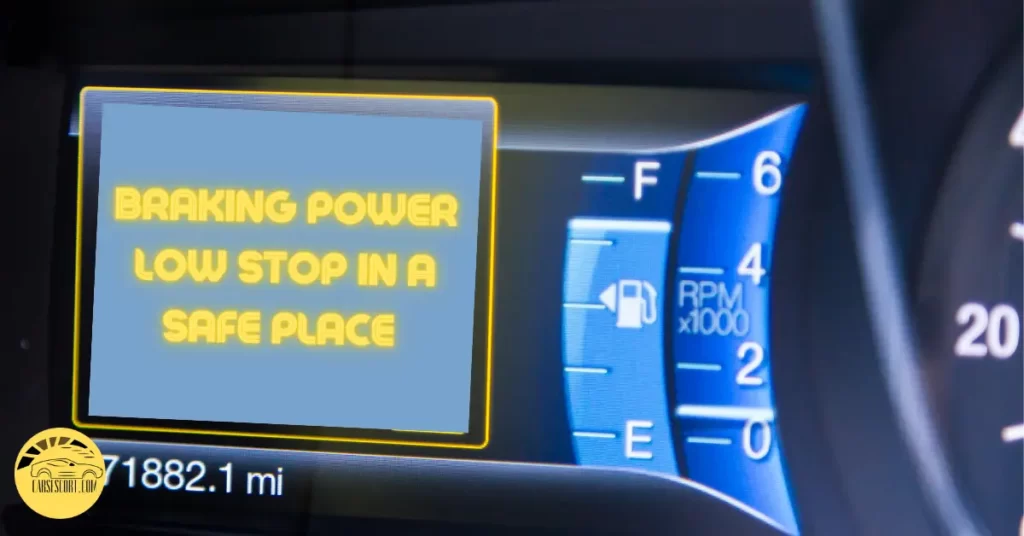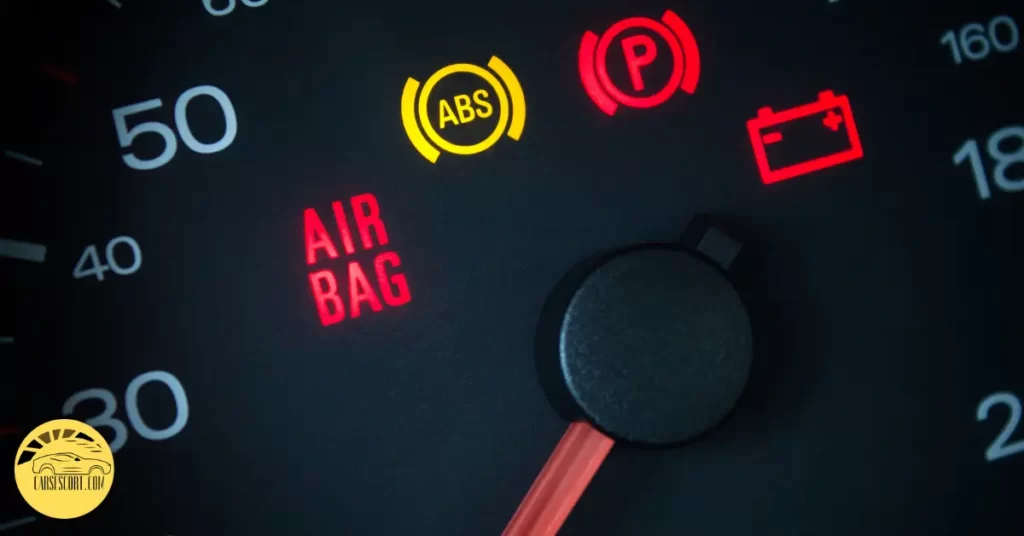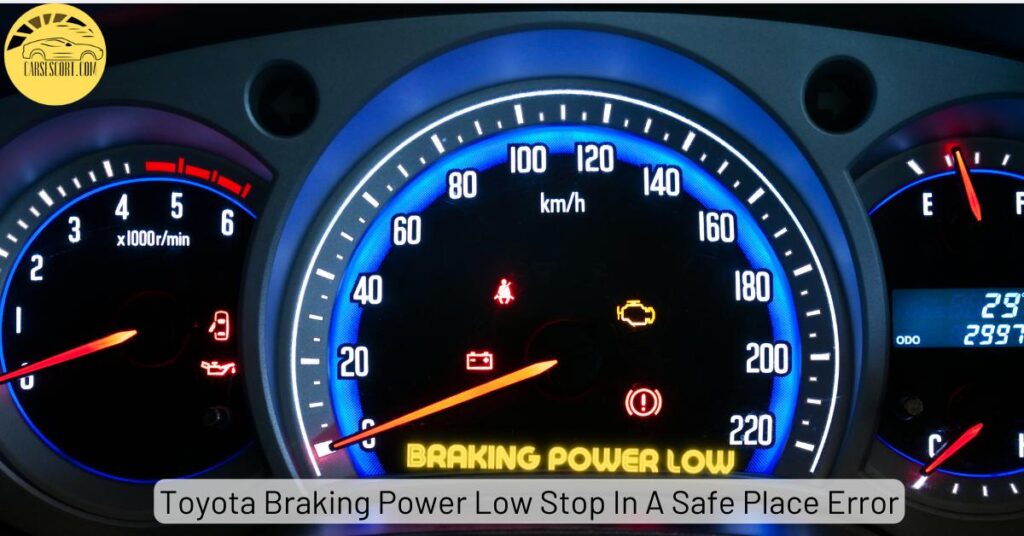When it comes to vehicle safety, braking power is of utmost importance. However, if you own a Toyota and encounter the error message “braking power low stop in a safe place,” it can be alarming.
Toyota braking power low stop in a safe place Error Means there is an issue with your braking system, particularly when the braking system isn’t getting the vacuum it needs. It signifies a problem with the braking system that requires immediate attention.
Other Causes too can contribute to the error pop-up include:
-
A Faulty Vacuum Pump.
-
Insufficient brake fluid.
-
Bad Vacuum Hoses.
-
Faulty brake master cylinder.
-
Faulty Brake Booster.
-
ABS Sensor Issues.
It’s crucial not to ignore this warning and address the issue promptly to prevent any accidents or further damage to your vehicle.
This article aims to guide you through troubleshooting and resolving this issue while ensuring your safety on the road.
We’ll explore the possible causes behind this error, provide step-by-step solutions, and offer some preventive measures to avoid it in the future.
What Does the Braking Power Low Stop in a Safe Place Error Mean in Toyota?
The “Braking Power Low ” error message in Toyota vehicles warns drivers that there is an issue with the braking system. This error indicates that the braking system is not receiving the required vacuum to operate efficiently.
Without sufficient vacuum, the braking system may experience reduced performance, making it essential to address this error promptly.

Braking Power Low Stop In A Safe Place Causes and Fixes
1) Faulty Vacuum Pump
A faulty vacuum pump can give rise to a range of issues, particularly regarding vehicle performance. In the case of Toyota vehicles, one of the prominent consequences of a faulty vacuum pump is a low braking power code.
The vacuum pump is critical in generating the pressure for the power brake booster system. When the pump malfunctions or fails, it can decrease the vacuum pressure, leading to insufficient braking power.
To fix a faulty vacuum pump, several steps can be taken. Firstly, it is important to diagnose the exact cause of the malfunction. This may involve visually inspecting the pump and checking for any visible damage or leaks.
Testing the pump’s functionality using specialized tools and equipment can also help identify the specific problem. Once the issue is pinpointed, the appropriate repair or replacement procedure can be undertaken.
This might involve repairing damaged components, replacing worn-out parts, or installing a new vacuum pump.
Following the manufacturer’s guidelines and consulting a professional mechanic or authorized service center is crucial to ensure a proper and reliable repair.
2) Insufficient Brake Fluid
Insufficient brake fluid can be a significant factor behind the error message “braking power low, stop in a safe place.” Brake fluid plays a crucial role in the hydraulic braking system of a vehicle, transmitting the necessary pressure to engage the brakes effectively.
When the fluid level is too low, it can decrease braking performance and potentially compromise the vehicle’s safety.
There are a few possible causes for low brake fluid levels. One common reason is a leak in the brake system, which can occur due to damaged brake lines, worn-out seals, or faulty brake calipers or wheel cylinders.
General wear and tear over time can contribute to a gradual decrease in fluid levels.
To fix the issue of insufficient brake fluid, it is essential to identify and address any leaks in the brake system. A thorough inspection of the brake lines, calipers, wheel cylinders, and master cylinders can help pinpoint the source of the leak.
Once the leak is located, the damaged component should be repaired or replaced accordingly.
This may involve replacing a worn-out seal, repairing a damaged brake line, or installing a new brake caliper or wheel cylinder.
After addressing the leak, refilling the brake fluid to the appropriate level is crucial.
3) Bad Vacuum Hoses
Bad vacuum hoses can lead to a range of issues, particularly in Toyota highlander, and one of the significant problems caused by these faulty hoses is a decrease in braking power.
Vacuum hoses play a crucial role in maintaining the vacuum pressure required to properly function various components in a vehicle, including the brake booster.
When these hoses deteriorate or develop leaks, it can result in a loss of vacuum pressure, decreasing braking power. This can be a serious safety concern, as reduced braking power may compromise the ability to effectively bring the vehicle to a halt.
To fix the problem of bad vacuum hoses causing low braking power in Toyota highlander, the following steps can be taken:
-
Start by inspecting the vacuum hoses in the vehicle. Look for any visible signs of damage, such as cracks, splits, or leaks. Pay close attention to areas where the hoses are connected to other components, as these junctions are prone to leaks.
-
If any vacuum hoses are found to be damaged or leaking, they should be replaced promptly. It is essential to use high-quality hoses compatible with the specific make and model of the Toyota vehicle.
-
Ensure the new vacuum hoses have the appropriate connections and fittings. Make sure they are securely fastened to prevent any future leaks.
-
After replacing the vacuum hoses, perform a thorough system check to verify that the braking power has been restored. Test the brakes under controlled conditions to ensure they are functioning optimally.
4) Brake Master Cylinder Issues
The brake master cylinder is a critical component of a vehicle’s braking system, responsible for converting the force on the brake pedal into hydraulic pressure that applies to the brakes.
When the brake master cylinder malfunctions, it can lead to various issues, including a significant reduction in braking power. In the case of Toyota vehicles, a common problem associated with the brake master cylinder is a low braking power code.
To fix this problem, several steps can be taken. First, it is essential to diagnose the specific issue with the brake master cylinder. This can be done by inspecting the cylinder for any visible signs of damage or leakage.
If a leak is detected, it may indicate a faulty seal or a worn-out piston. In such cases, the brake master cylinder may need to be replaced.
It is crucial to ensure that the brake fluid level is adequate and that there are no contaminants or air bubbles in the system. If the brake fluid is low, it should be replenished to the recommended level.
If contaminants or air bubbles are present, the brake system may need to be bled to remove them.
5) Faulty Brake Booster
A faulty brake booster can lead to various issues, particularly regarding braking power. In the case of Toyota vehicles, a common cause of the “braking power low” code is a faulty brake booster.
The brake booster is a crucial component of the braking system that amplifies the force applied to the brake pedal, allowing for efficient braking.
When the brake booster malfunctions, it can decrease braking power, making it difficult to bring the vehicle to a stop effectively and safely.
Several steps can be taken to fix the problem of a faulty brake booster. Firstly, it is important to diagnose the issue accurately by thoroughly inspecting the brake booster and related components.
This may involve checking for any visible signs of damage, leaks, or worn-out parts. A diagnostic scan can also be performed to identify any error codes related to the brake booster.
Once the problem is identified, replacing the faulty brake booster with a new or refurbished one is the most effective solution.
This process typically involves removing the old brake booster and installing the new unit, ensuring all connections are secure and properly aligned.
Using genuine or high-quality replacement parts is crucial to ensure optimal performance and reliability.
6) ABS Sensor Issues
ABS sensor issues can lead to various problems, and one of the primary causes of the “braking power low” code in Toyota vehicles is ABS sensor malfunction.
The ABS (Anti-lock Braking System) sensor plays a crucial role in monitoring the speed of each wheel and transmitting that information to the ABS control module.
This data determines if any wheel is about to lock up during braking, allowing the system to modulate the brake pressure to that specific wheel and prevent skidding.
When the ABS sensor malfunctions, it can result in inaccurate readings or a complete signal loss, triggering the “braking power low stop in a safe place” code.
To address ABS sensor issues, several steps can be taken. First, diagnosing the specific problem using a diagnostic tool to retrieve the ABS fault codes is essential.
This will help identify the faulty sensor or any other related issues. Once the problematic sensor is identified, it may need to be cleaned, as debris or dirt accumulation can interfere with its functionality. Sometimes, the sensor may require replacement if it is damaged or worn out.
Checking the wiring connections and ensuring they are securely attached can help resolve connectivity issues.

Preventive Measures to Avoid the Error
To minimize the chances of encountering this error in the future, consider the following preventive measures:
-
Adhere to your vehicle’s recommended maintenance schedule, which includes regular inspections of the braking system. Routine check-ups can help identify potential issues before they escalate into major problems.
-
Periodically check the brake fluid level to ensure it is within the recommended range. If you notice a significant drop in the fluid level, have your vehicle inspected by a professional to identify and repair any leaks.
-
Stay proactive by replacing brake pads and shoes according to the manufacturer’s guidelines or as your mechanic recommends. Regularly inspecting these components for wear and tear can help maintain optimal braking performance.
-
When replacing brake pads, shoes, or other brake components, opt for high-quality OEM (Original Equipment Manufacturer) parts. Using genuine parts ensures compatibility and reliability, enhancing overall braking performance.
-
Develop good driving habits that are gentle on your brakes. Avoid sudden and aggressive braking whenever possible. Anticipate traffic flow and use gradual braking to reduce unnecessary strain on the braking system.
-
Avoid overloading your vehicle beyond its recommended weight capacity. Excessive weight can stress the brakes more, potentially leading to premature wear and decreased braking efficiency.
You May ALso Like To Read:
- Why Should You Be in The Proper Gear Before Starting Down a Hill?
- Traction Battery Needs To Be Protected Error
FAQ
How do you lose braking power?
You can lose braking power due to various factors such as worn brake pads, brake fluid leakage, a malfunctioning brake system, or insufficient friction between the brake pads and the rotor.
Which braking method is appropriate for safety?
The appropriate braking method for safety depends on the situation. In general, a combination of both gentle and progressive application of the brakes is recommended, along with maintaining a safe following distance, using the appropriate braking force for the speed and road conditions, and avoiding abrupt or harsh braking maneuvers.
What is grade braking?
Grade braking, also known as engine braking or downhill braking, is a technique used to control the speed of a vehicle while descending a steep incline.
Instead of relying solely on the vehicle’s brakes, grade braking involves using the engine’s resistance to slow down the vehicle by shifting to a lower gear or engaging the vehicle’s engine braking system.
What is normal braking pressure?
Normal braking pressure refers to the typical force exerted on the brake pedal to slow down or stop a vehicle under normal operating conditions.
The specific pressure can vary depending on the vehicle’s design, braking system, and driver preference, but it generally requires applying gradual and consistent pressure to achieve effective braking without locking up the wheels.
My Final Thoughts
Experiencing your Toyota’s “braking power low stop in a safe place” error can be concerning. Still, by following the troubleshooting steps outlined in this article, you can address the issue effectively and ensure your safety on the road.
Remember to promptly inspect brake fluid levels, pads, the master cylinder, and ABS sensors to identify and resolve any underlying problems.
Adopting preventive measures and maintaining regular vehicle inspections will help minimize the chances of encountering this error in the future.
By prioritizing the safety and maintenance of your braking system, you can enjoy a smooth and secure driving experience in your car.
Affiliate Disclosure: Cars Escort is a participant in the Amazon Services LLC Associates Program. As an Amazon Associate, we earn from qualifying purchases made through affiliate links on our site. Read Our Disclaimer .

